
‘Show him the spiced plums, mother. Americans don’t have those,’ said one of the older boys. ‘Mother uses them to make kolaches,’ he added. Leo, in a low voice, tossed off some scornful remark in Bohemian. I turned to him. ‘You think I don’t know what kolaches are, eh? You’re mistaken, young man. I’ve eaten your mother’s kolaches long before that Easter Day when you were born.’
– Willa Cather’s novel My Antonia (1918), about Bohemian immigrants in Nebraska in the 1880s
Sometimes there is a fine line between cakes, breads, and pastries. The Czech koláč (koláče plural) –- the hacek mark over the letter “c” makes it a guttural “ch” -— consists of a large sweet yeast dough round topped with pools of a sweet mixture (or several types), while its diminutive koláček (koláčky plural) denotes smaller individual versions. In America, the names were anglicized, depending on the part of the country, as kolache or kolacky (typically used for both large and small cakes as well as both plural and singular).
Round breads are some of the earliest of ritual foods, variously symbolizing the sun, moon, and female. In this vein, the Slavonic word for wheel (kolo) gave its name to an ancient Eastern and Central European ritual round savory bread loaf. Then, around the 15th century with the arrival in Eastern Europe of yeast breads enriched with butter, eggs, and sugar (the first light cakes in the region), the name kolo was applied to round sweetened yeast loaves enjoyed for celebrations from the Balkans to the Baltic Sea, including the Polish kolacz (pronounced kowatch), Russian kulich, Ukrainian kolač, Serbo-Croatian kolač, Hungarian kalacs, and Yiddish koyletch (an early synonym for egg challah, considered a cake by Sephardic Jews). Distinct from the unadorned yeast cakes of Eastern Europe (or those additionally flavored with raisins), varieties from Bohemia, Moravia, and Slovenia were paired with povidla (plum butter made from cooking down Italian plums without the addition of sweeteners). Some speculate that originally people simply spread the beloved povidla on chunks of baked sweet bread to enhance the gastronomic experience. Then around the 18th century bakers began making indentations in the dough rounds before baking and filling them with povidla, resulting in a sort of a massive ‘prune Czech’ (instead of Danish). The radiating pockets of topping actually looks more like a wheel. Related to kolache are Czech buchty (buchta singular), a bun with the sweet mixture enclosed inside. The rich dough is also wrapped around a large sausage (klobasnek).
Besides plum (slivkóvý koláče or povidlové koláče), two other venerable central European baking favorites became traditional Old-World kolache toppings: Poppy seed (makový koláče) and cheese (tvaroh koláče). These items were easily produced by families with even only a little land and capable of extended storage to be on hand when needed for various treats. Regular jam cannot be used for kolache as it soaks into the dough and boils over during baking. In Europe, Czechs used a form of the Teutonic quark for the cheese topping and, in 19th century America, substituted drained clabber; more recently, cream cheese and/or farmer cheese emerged as the principal cheese. More modern toppings include apricot, blueberry, cherry, lemon, pineapple, and raisin. For a dazzling presentation, each indentation of a large cake round is filled with a different flavor and color. A relatively recent innovation is an optional streusel topping known as posipka.
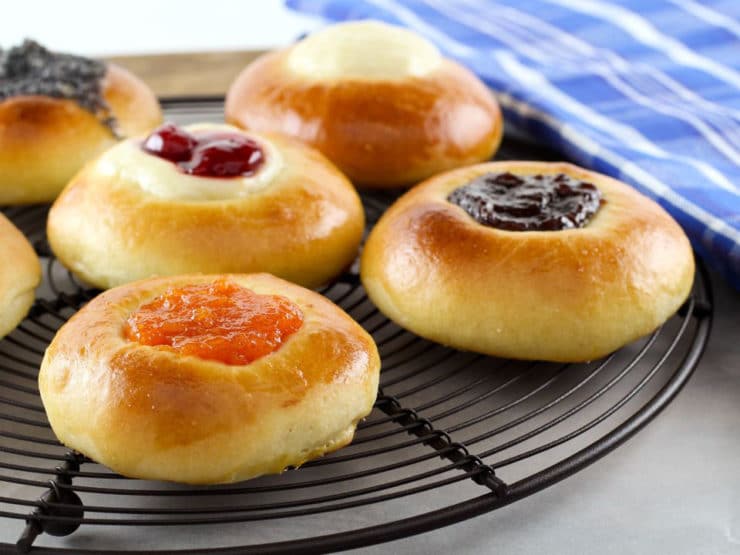
Many Czech families had their own secret kolache recipe handed down from generation to generation, mothers and grandmothers assiduously instructing the young girls. The dough, abounding with butter, should be rather dense, not fluffy. Some prefer a plain flavor, while others add a hint of spice or lemon zest to the dough. Most traditional versions call for three risings, but some aficionados insist that five risings are necessary for proper texture and flavor. Modern cookie adaptations, particularly prominent among Poles, use sour cream or cream cheese pastry dough instead of the traditional yeast, but the latter remains the most common and authentic.
Perhaps the first mention of this treat outside central Europe was in Leaves From My Journal During Summer of 1851 by Robert Grosvenor (London, 1852): “Outside the sacred precincts [of ritual baked goods] there are such things as Kugellhopf, a species of Baba, and Bohmische kolatchen [the German plural spelling], a local luxury, made of heavier materials, sometimes a little cheese finding its way into it; excellent in their way, but not to be thought of by the docile water-drinker; the latter he must not approach till he has left off drinking six weeks.”
Czech immigrants began arriving in central Texas in the 1840s, with many more following in the ensuing four decades, founding in that state more than 250 small communities, constituting the largest rural Czech population in America. Significant numbers of Czechs also settled in Minnesota, Wisconsin, Nebraska, Iowa, Illinois, and other parts of the Midwest. Although most quickly adopted American fare, they tended to continue to enjoy certain traditional foods, in particular kolache. In Europe, home ovens were exceedingly rare, whereas in America they were commonplace, facilitating home baking. In Europe, these treats contained very expensive ingredients (sugar, eggs, butter, and white flour) and were initially reserved for very special occasions, specifically Epiphany and, along with masquerades and dances, on Mardi Gras (Shrove Tuesday) in the pre-Lenten festivities. For Christmas there might be depressions in a large round cake for candles. Traditionally, newly engaged women sent small kolache with three toppings to family and friends as an invitation to the wedding. In America, kolache became common not only for all special events but also as a beloved comfort food and vehicle for ethnic identification. Czechs in America enjoyed their coffee with kolache, becoming a way of entertaining neighbors and making more bearable the hardships and isolation of farm life. These treats became ubiquitous at church dinners and bazaars. Many Czechs in America grew their own poppies to ensure an adequate supply of seeds for the topping (Minnesota: A State Guide Federal Writers’ Project, 1938) and numerous families bottled their own povidla. Others had to make do with stewing prunes. A “kolache odor” was considered the characteristic aroma of Midwestern Czech homes.
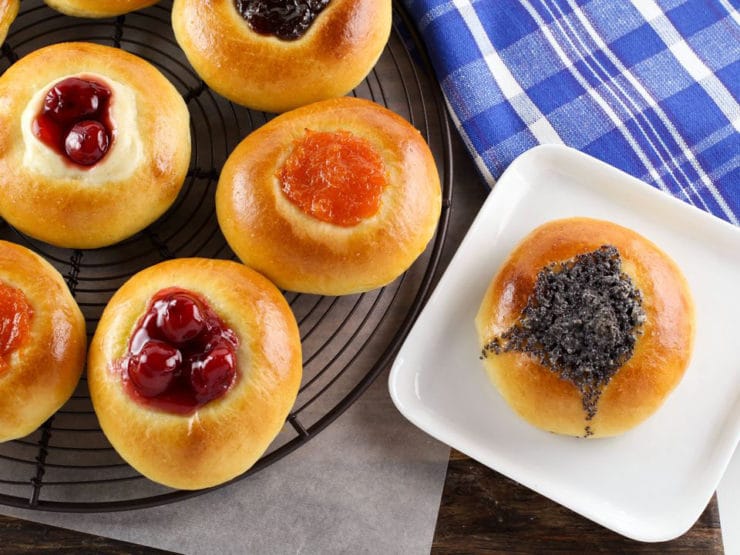
An early written presence of this cake in America was in The Chicago Record Cook Book (Chicago, 1896), a collection of ten thousand recipes submitted by readers to a regular newspaper column, the instructions (along with “Brown Farina Soup,” “Chopped Veal Leg,” and “Noodle Pudding”) provided by Mrs. Mary A. Cizkovsky of Chicago: “Stuffed Biscuits (Bohemian kolace) — Into one pound of flour put a cent’s worth of yeast, prepared, one egg, one tablespoon butter or lard, one scant pint of lukewarm milk, one level teaspoonful salt. Mix thoroughly with wooden spoon, working the dough till smooth. Set in warm place to raise and cover it. When raised put on a floured kneading board. Roll out to about half an inch in thickness, cut in circular shape, place in greased dripping-pan without touching. Rub over with butter or lard (melted). Take out pits from prunes left over from luncheon. Chop the prunes and put a little of the Jam on the center of each biscuit. Let raise again and bake to a light brown. To prepare the yeast crumble it into a cup with one tablespoonful sugar and one quarter cup warm milk. Mix and use as soon as it rises.”
Soon thereafter, the cake appeared in the initial edition of The Settlement Cook Book (Milwaukee, 1901), as a trio of different small types of “Kolatchen” with a German-Jewish influence: Bohemian Kolatchen, Sour Cream Kolatchen, and Ice Kolatchen. The “Bohemian Kolatchen” resembled the modern American small type, but was filled with beaten egg white sprinkled with sugar rather than prune or poppy seed: “Make Kuchen Dough, No. 1, 2 or 3, pages 311 and 312. Add a little cinnamon and mace and 1 teaspoon anise, seed well pounded, or flavor to taste. Let rise till very light, then take out on mixing board, and roll out to about half inch. Cut in rounds, 3 inches in diameter, and lay on a well-buttered pan, pressing down the centre of each so as to raise a ridge around the edge. When well risen, brush the top over with stiffly beaten white of an egg and sprinkle with granulated sugar.” The “Sour Cream Kolatchen” were rather small yeast cookies, the dough dropped from a teaspoon and topped with a small piece of dried or candied fruit. The “Ice Kolatchen” utilized a rudimentary form of Danish pastry “cut into rounds with biscuit cutter 3 inches in diameter, place on floured board and let rise in a warm place until light several hours. Place a teaspoon of raspberry jam on lower half of each piece, then fold over the other half and press edges together.”
Lady Bird Johnson, in the July 7, 1967 entry in her White House Diary (published in 1970), described a trip to Praha, a community in Fayette County Texas founded by Czechs and named for Prague, reflecting the assimilated Czechs retaining their kolache tradition: “The tables were loaded with fried catfish and black-eyed peas, fried chicken and thick slabs of homemade bread, and for dessert a typical specialty of the area – ‘kolaches,’ a rich pastry that has a center of dried apricots or prunes.” Since 1984, Burleson County Texas to usher in the fall has sponsored an annual one-day “Kolache Festival,” celebrating Czech heritage and featuring baking competitions and a kolache-eating contest. The 71st Legislature of Texas proclaimed the Burleson County Seat of Caldwell as “Kolache Capital of Texas.” At the 2007 festival, around 25,000 guests consumed more than 60,000 kolache. In the following year, the festival went on despite the threat of Hurricane Ike. Similar large celebrations emerged in several other Texas communities, including Crosby, Fayetteville, Hallettsville, and West.
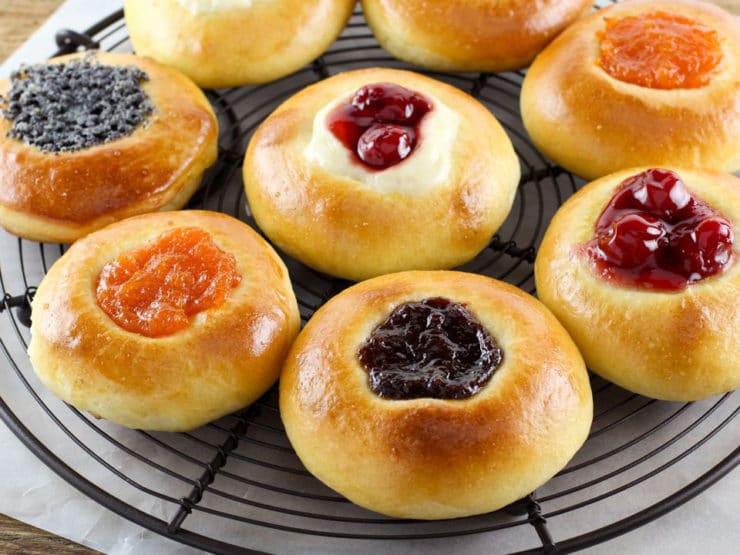
The southern Minnesota town of Montgomery, just south of New Prague, claiming the title of “Kolacky capital of the world,” holds its own annual Kolacky Days Festival. The Montgomery celebration, dating from just days before the stock market crash in 1929, eventually became a three-day series of events during the first weekend in August. Although many of the original ethnic overtones of the festival dissipated over the years, kolacky remain, including the home-baked kolacky contest featuring prizes for the Best Tasting (in traditional and non-traditional toppings), Most Perfectly Shaped, and Largest. Kolache are also featured at annual Czech Fests and Kolache Days in Wilson, Kansas; Wilber, Nebraska; Prague, Oklahoma (nicknamed Kolache-ville); Yukon, Oklahoma; and the Kolache Shoot-out in Elba, Nebraska. These events most commonly occur in August and September corresponding to the maturation of Italian plums.
Until well into the 20th century, kolache generally remained the province of Czech homes. Even Ray Kroc’s attempt in the 1950s to add “kolacky,” his mother’s specialty, to McDonald’s menu failed. A recipe was included in the Betty Crocker’s Picture Cook Book (1950) as well as the New Picture Cook Book (1961), the cake introduced to General Mills by a staff member from Minnesota. Webster’s Dictionary added kolacky and kolach in 1961, signifying its movement into the American mainstream. The treat, proving rich and flavorful but not cloying, became commonplace in many American bakeries and cookbooks.
Meanwhile, kolache in America transposed from being a homemade treat to increasingly a commercial product. Besides bakeries, a number of doughnut stores and other franchises in Texas sell them. There are even restaurants in Texas and Indiana specializing only in assorted sweet and savory kolache. A few of these establishments no longer make traditional plum kolache, but offer unorthodox versions, such as sausage-jalapeño-and-cheese (actually a klobasnek) and, in November, pumpkin-cheese. Still, some Czechs insist on preparing their own kolache at home (or church), like their mother and grandmothers before them.
Food Photography and Styling by Kelly Jaggers
Recommended Products:
We are a participant in the Amazon Services LLC Associates Program, an affiliate advertising program designed to provide a means for us to earn fees by linking to Amazon.com and affiliated sites. As an Amazon Associate I earn from qualifying purchases.
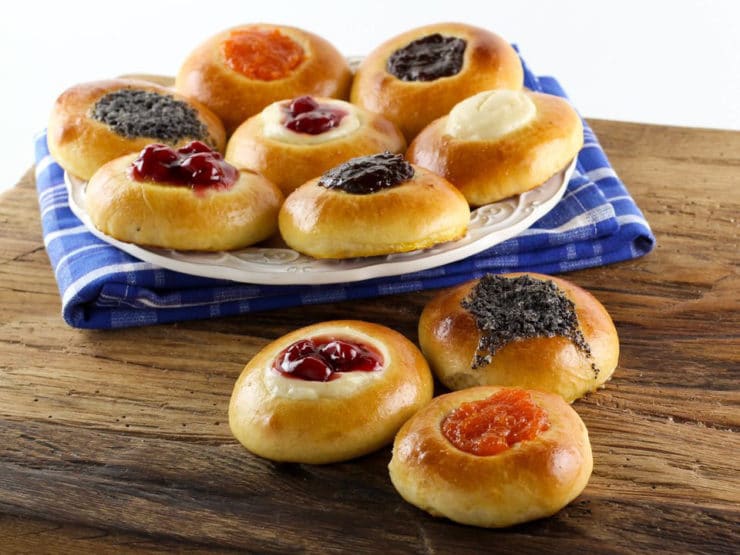
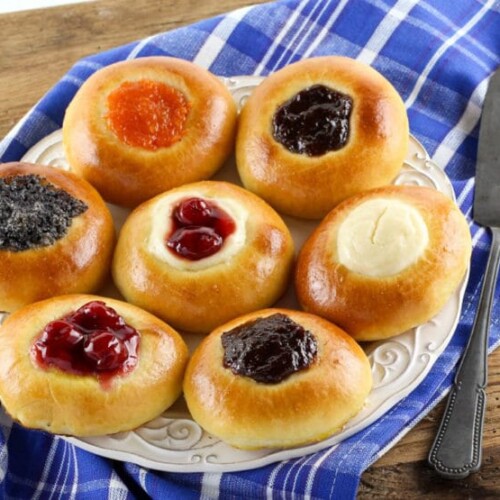
Kolache/Kolacky
Ingredients
Dough
- 1 package active dry yeast (¼-ounce/7 grams/2¼ teaspoons), 1¾ teaspoons instant yeast, or 1 cake fresh yeast (0.6-ounce/18 grams)
- 1 cup warm milk (105 to 115°F for dry yeast; 80 to 85°F for fresh yeast)
- 1/2 cup unsalted butter, softened, or ¼ cup butter and ¼ cup shortening (1 stick/4 ounces/120 grams)
- 2 large eggs (6 tablespoons/3.5 ounces/100 grams)
- 6 tablespoons granulated sugar (3 ounces/80 grams)
- 1 teaspoon table salt
- 1 teaspoon grated lemon zest and/or ½ teaspoon ground mace or nutmeg (optional)
- 4 cups unbleached all-purpose or bread flour (17 ounces/500 grams)
Egg Wash
- 1 large egg (beaten)
- 1 teaspoon cream, milk, or water
Cheese Topping
- 16 ounces farmer cheese or cream cheese, softened (455 grams OR 10 ounces (285 grams) farmer cheese and 6 ounces (170 grams) softened cream cheese)
- 1/2 cup granulated sugar or more to taste (3.5 ounces/100 grams)
- 2 large egg yolks
- 2 tablespoons all-purpose flour (optional)
- 1 teaspoon vanilla extract (OR 1 teaspoon grated lemon zest, ½ teaspoon ground cinnamon, or ½ teaspoon grated nutmeg)
Poppy Seed Topping
- 2 cups poppy seeds
- 1 cup milk or water (8.5 ounces/240 grams)
- 1 1/2 cups granulated sugar (10.5 ounces/300 grams)
- 1 tablespoon fresh lemon juice or 3 tablespoons unsalted butter
- Pinch salt
- 1 teaspoon grated lemon zest (optional)
Prune Topping
- 1 pound pitted prunes, or 8 ounces pitted prunes and 8 dried pitted cherries (455 grams/about 36 medium/3 cups)
- 2 cups water (17 ounces/485 grams)
- 1/2 cup granulated sugar (3.5 ounces/100 grams)
- 1 tbsp lemon juice or prune juice
- 1/2 tsp ground cinnamon
- 1/8 tsp ground cloves (optional)
Apricot Topping
- 2 cups dried apricots (12 ounces/340 grams)
- 1 cup orange juice (or 1 cup water and 1 tablespoon lemon juice) (8.5 ounces/240 grams)
- 1/2 cup granulated sugar, light brown sugar, or honey (3.5 ounces/100 grams)
- 1-2 tablespoons lemon juice or dark rum
Blueberry Topping
- 1/3 cup granulated sugar (80 mL)
- 3 tablespoons cornstarch (45 mL)
- Pinch salt
- Pinch ground cinnamon (optional)
- 2 cups blueberries (about 10 ounces/285 grams)
- 2 tablespoons lemon juice (30 mL)
Cherry Filling
- 1/2 cup granulated sugar (3.5 ounces/100 grams/120 ml)
- 1/4 cup cornstarch (1.25 ounces/35 grams)
- 1 1/4 cups reserved cherry juice (300 mL)
- 28 ounces pitted sour cherries (800 grams/4 cups)
Posipka (optional)
- 1 cup granulated sugar (7 ounces/200 grams)
- 1/2 cup all-purpose flour (2.125 ounces/60 grams)
- 1-1 1/2 teaspoons ground cinnamon (optional)
- 1/4 cup butter, melted (½ stick/2 ounces/60 grams)
NOTES
In a medium bowl, beat the cheese and sugar until smooth. Blend in the yolks, optional flour, and vanilla.
To Make Poppy Seed Topping
In a nut grinder, coffee grinder, food processor, or blender, grind the poppy seeds. Grinding produces a finer texture and better flavor. In a medium saucepan, combine the poppy seeds, milk, sugar, lemon juice, salt, and optional zest. Simmer over a medium-low heat, stirring frequently, until the mixture thickens, about 10 minutes. Let cool. The topping can be covered and stored in the refrigerator for up to 1 week. It tastes much better than the canned stuff. To Make Prune Topping
In a bowl or large bottle, pour the water over the prunes and let stand at room temperature for several hours or overnight. In a large saucepan, simmer the prunes and water until very tender, about 30 minutes. Drain, reserving ¼ cup of the cooking liquid. To the hot prunes, add the sugar, lemon juice, cinnamon, and optional cloves and mash until smooth. Stir in the reserved cooking liquid. Let cool. The topping can be covered and stored in the refrigerator for up to 5 days. To Make Apricot Topping
In a medium saucepan, simmer the apricots and orange juice over medium heat until tender, about 30 minutes. Drain. In a food processor, puree the apricots with the sugar and lemon juice until smooth. The topping can be covered and stored in the refrigerator for up to 3 days.
To Make Blueberry Topping
In a medium saucepan, combine the sugar, cornstarch, salt, and, if using, cinnamon. Add the blueberries and lemon juice. Cook over medium heat, stirring, until the sugar dissolves. Reduce the heat to low and simmer until thickened (about 10 minutes). Let cool. (Filling can be stored in the refrigerator for up to 3 days.) To Make Cherry Topping
In a medium saucepan, combine the sugar and cornstarch. Stir in the juice. Cook, stirring, over medium heat, until the mixture boils and thickens. Remove from the heat and stir in the cherries. Let cool. (Filling can be stored in the refrigerator for up to 3 days.)
To Make Posipka (optional)
In a medium bowl, combine the sugar, flour, and optional cinnamon. Using a fork or your fingers, stir in the butter to make fine crumbs.
Instructions
- In a small bowl or measuring cup, dissolve the yeast in ¼ cup milk. If using instant yeast, do not dissolve it yet-- reserve.

- In a large bowl, combine the yeast mixture with the remaining milk, butter, eggs, sugar, salt, and, if using, zest and/or mace. Blend in 1½ cups flour. If using instant yeast, add it now.

- Gradually add enough of the remaining flour to make a workable dough.

- On a lightly floured surface or in a mixer with a dough hook, knead the dough until smooth and springy, about 5 minutes.

- Place in an oiled bowl and turn to coat.

- Cover with a kitchen towel or loosely with plastic wrap and let rise in warm, draft-free place until nearly doubled in bulk, 2 to 3 hours, or in the refrigerator overnight.

- Punch down the dough, knead briefly, cover, and let rise in a warm, draft-free place until nearly doubled in bulk, about 1¼ hours.

- Line a large baking sheet with parchment paper or lightly grease the sheet. Punch down the dough, knead briefly, divide in half, form into balls, and let stand for 10 minutes.

- On a lightly floured surface, roll out the dough ½ inch thick. Cut into 2½-inch rounds. Reroll and cut out the scraps.

- Place on parchment paper-lined or greased baking sheets about 1 inch apart, cover with a towel or plastic wrap spritzed with cooking spray, and let rise at room temperature until nearly doubled in bulk, about 1 hour.

- Position a rack in the center of the oven. Preheat the oven to 375°F (350°F for a convection oven). Using your thumb or the back of a spoon, press 1 large or 2 smaller deep indentations into the center of each round, leaving a ½-inch wide-rim. Brush the edges with the egg wash.

- Spoon about 1 tablespoon topping into the indentation and, if using, sprinkle lightly with the posipka.

- Bake until golden brown or the center of the dough registers about 180°F on an instant-read thermometer, about 12 minutes. Transfer to a wire rack and let cool.Kolache are best eaten on the same day they are made, but can be covered with plastic wrap and stored at room temperature for up to 2 days on in freezer for up to 3 months.

VARIATIONS:
- For 12-inch round cakes: On a lightly floured surface, roll each half into a 12-inch round. Place on the prepared sheet, leaving several inches between each round. Cover with a towel or plastic wrap spritzed with cooking spray and let rise at room temperature until nearly tripled, about 1½ hours.Position a rack in the center of the oven. Preheat the oven to 375°F (350°F for a convection oven).

- With a large spoon or your thumb, press 6 evenly spaced deep large triangular indentations into the dough, leaving a ½-inch-wide outer rim and between the indentations. Brush the edges with the egg wash.

- Fill each section with about 1/3 cup of 3 or 6 different toppings. If using, sprinkle lightly with the posipka.Bake until golden brown or the center of the dough registers about 180°F on an instant-read thermometer, 15 to 25 minutes. Transfer to a wire rack and let cool.

Nutrition

tried this recipe?
Let us know in the comments!
THK wants to know… what’s your favorite kolache topping?


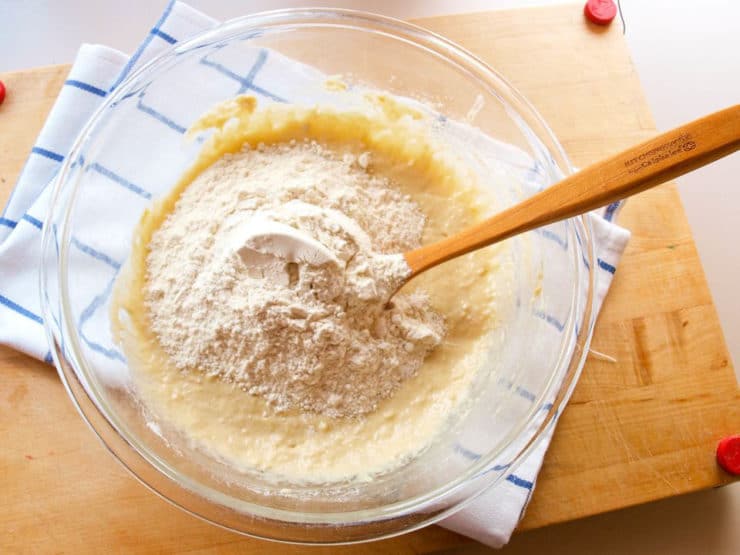
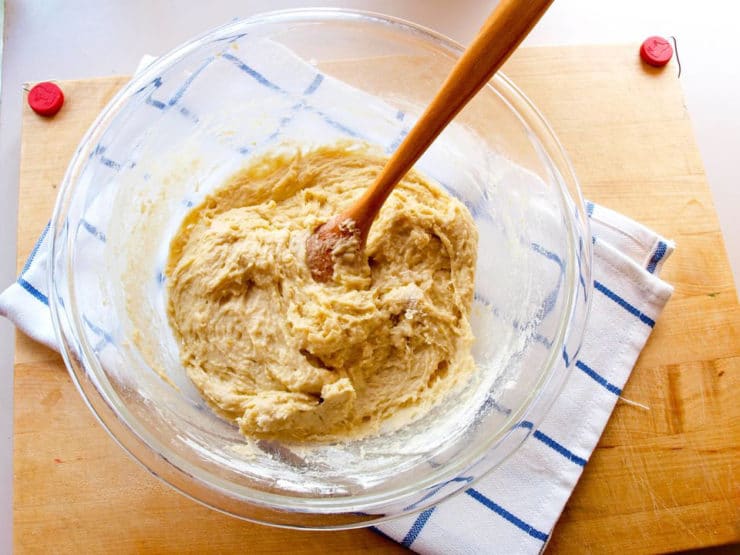
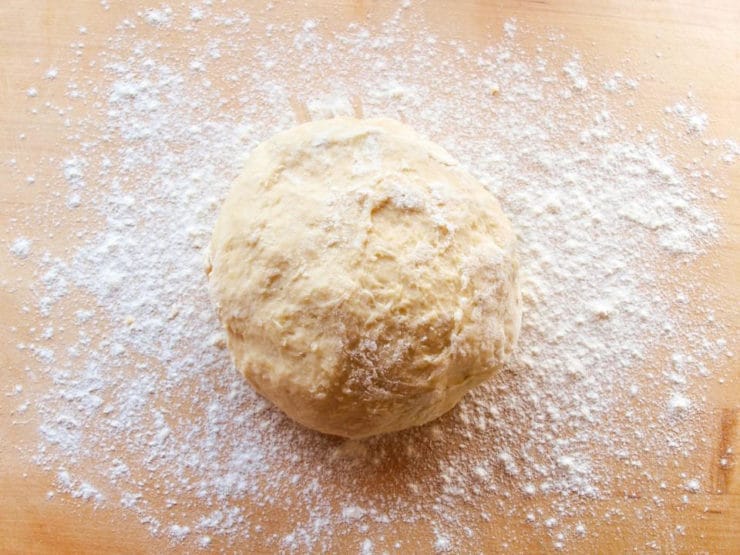
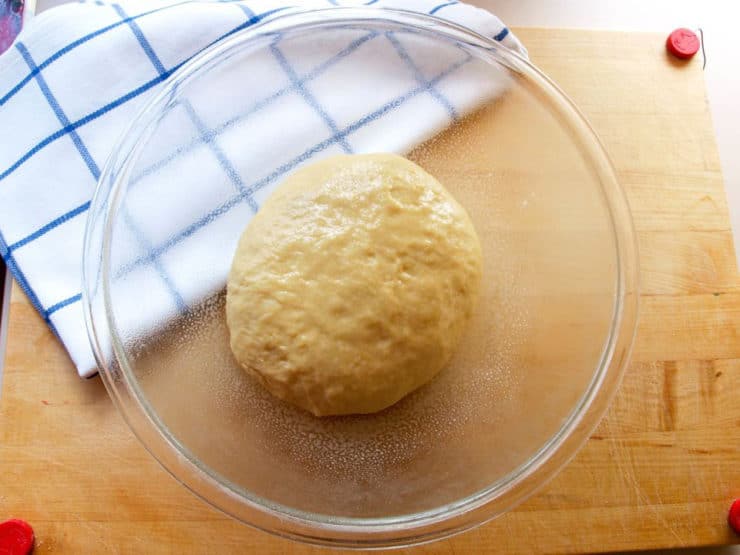
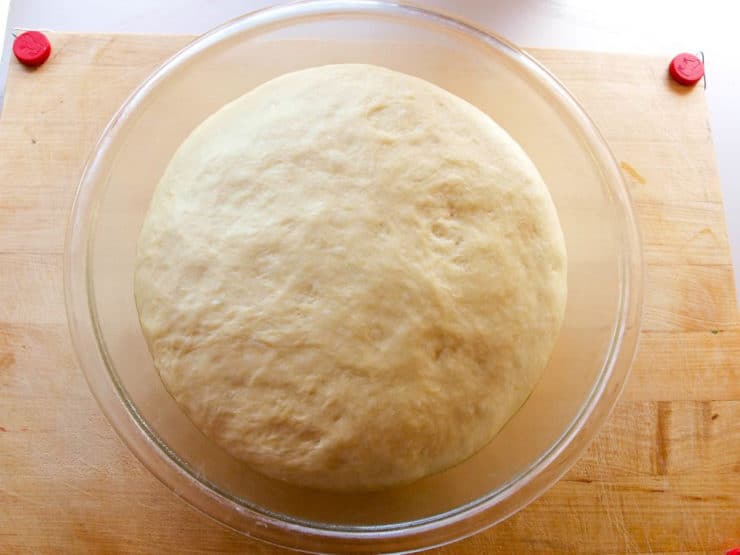
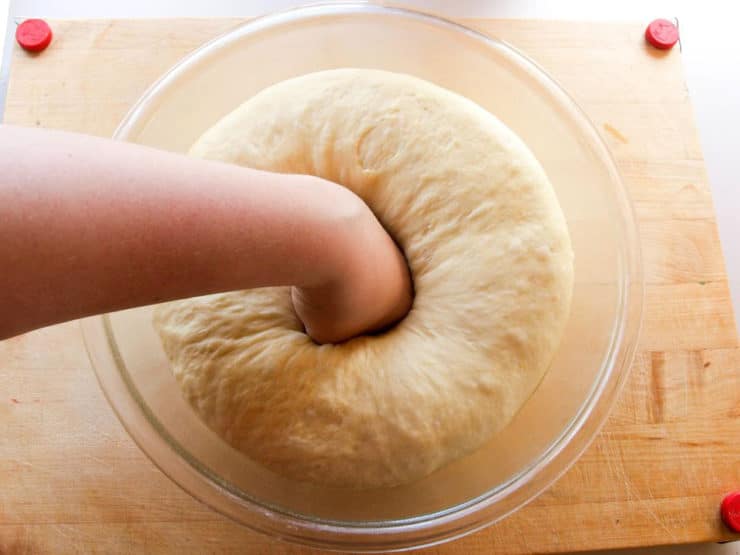

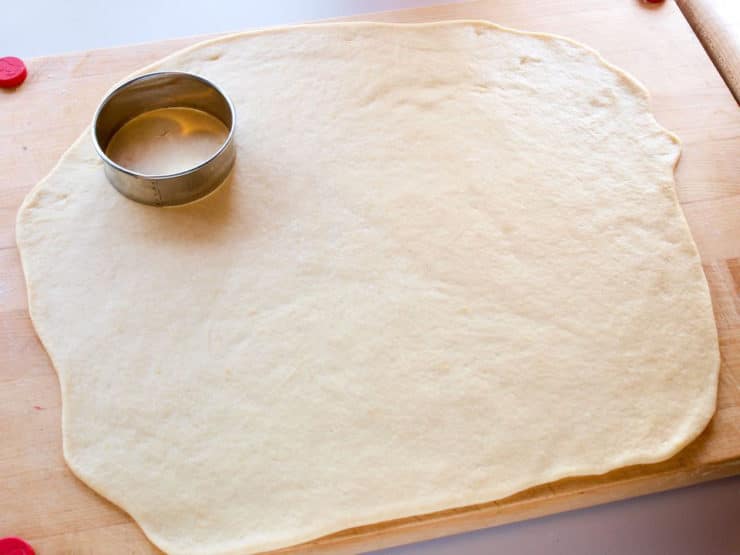
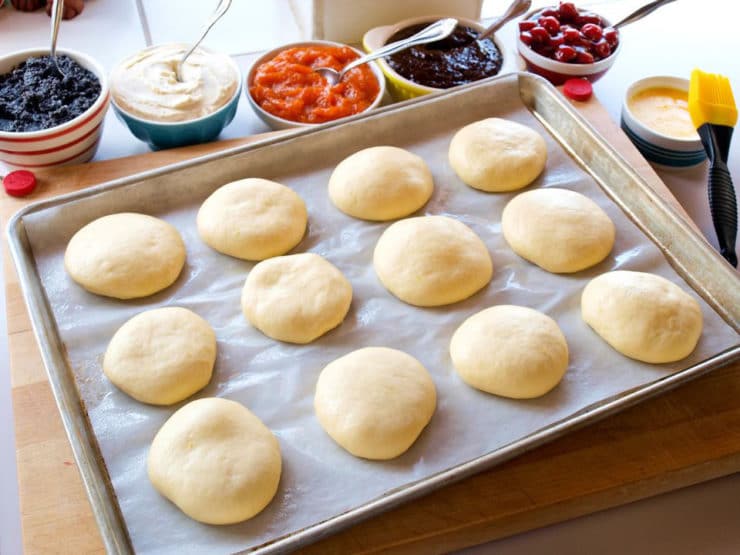
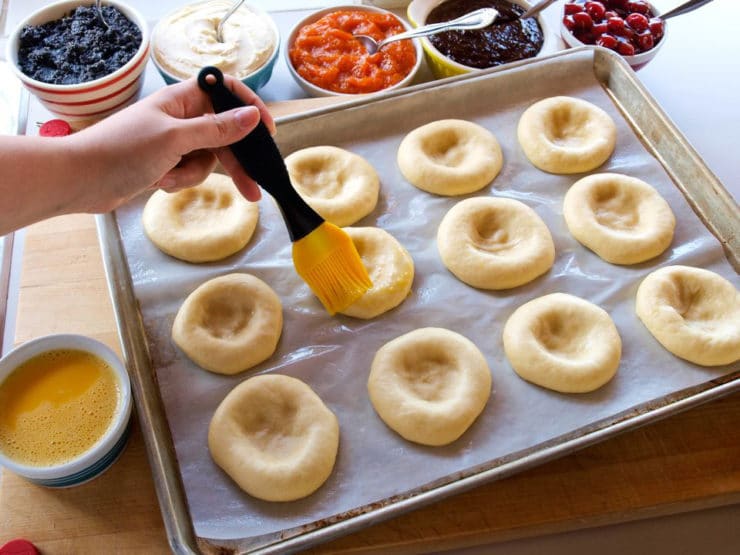
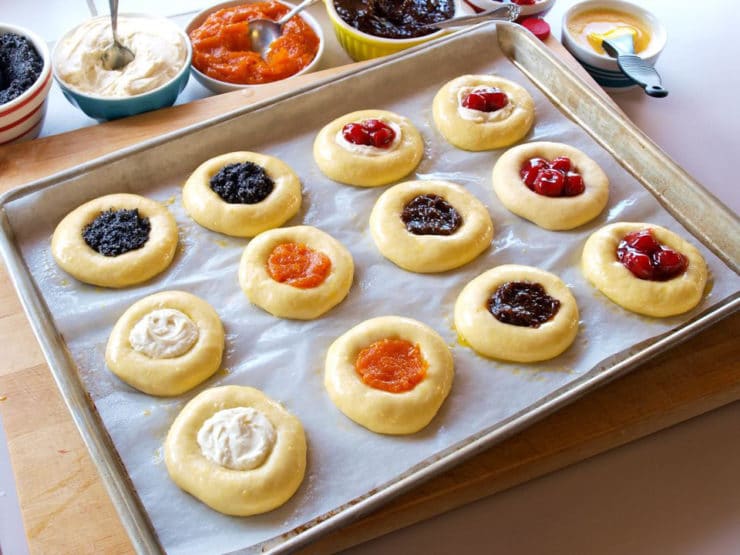
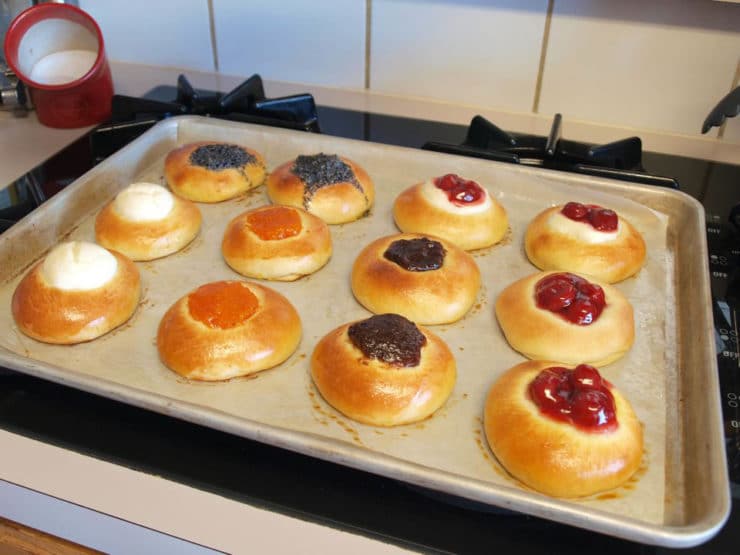
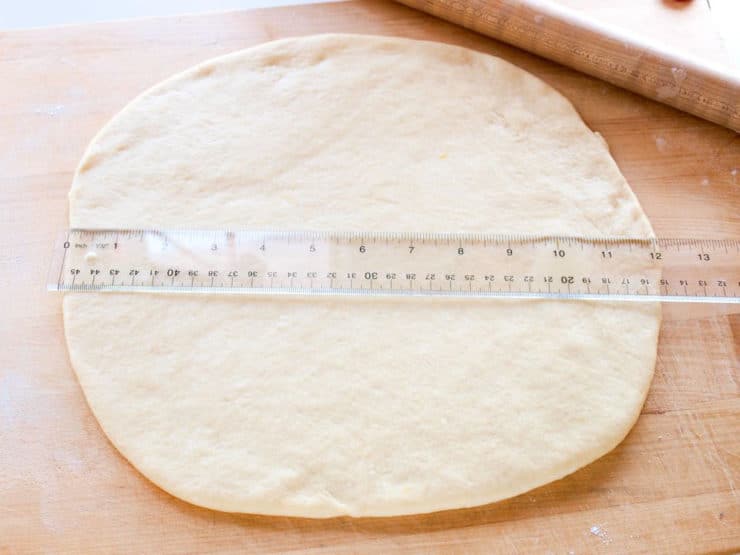
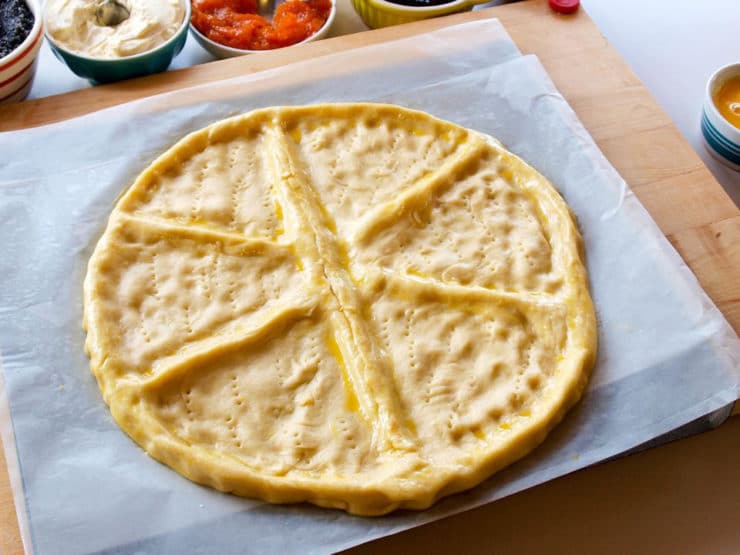
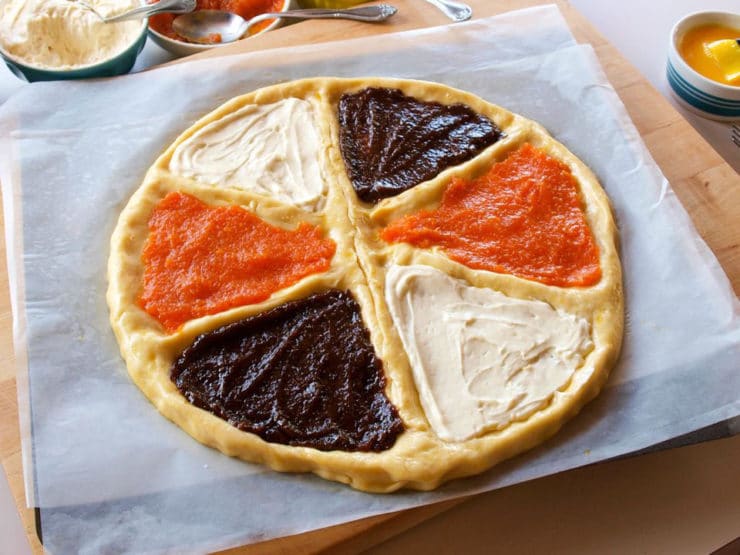


I am very impressed with your web. Site. How you show how to make the dough. I was enthralled.exactly what I needed. Sometimes I feel so insecure when making dough. When my mom was alive (may she rip) I would ask her specific questions about how hot shoud water be for yeast etc. she say “well you know not too hot. “. No I didn’t know that’s why I was asking her. That was many moons ago. I did learn trial and error. I would love to print out your directions. But I’m using an apple I pad, and I don’t know ho to use. Printer with it. My desk computer needs help right now. What I was looking for on line is an easy moist dough for long nut rolls which my mother alway called “Kolachy” we are 100% Italian but our neighborhood was mixed nationalities. So we taught each other. I will make your dough recipe but make long rolls , rather then the cute little bun like filled rolls. I’ll do them another time . Thank you. Shirl
My great-grandmother made the kind described above as “buchta” . And the recipe handed down is similar for dough recipe (always use the lemon zest). Apricot or prune filling, or mix both together. To enclose the filling you handle each piece of dough with filling, wrapping dough over the filling, similar to way one makes smooth balls for cloverleaf dinner rolls. Then on top is brown-sugar-butter crumbs and no egg glaze. The name for these were kolache or “bobbies” …. derived from buchta?? I am excited to find a possible source for the bobbie name. Great-grandma and Great-grandpa’s families came separately from Moravia near the Polish Border, and near the Silesian region. I know some town names if one is interested. Many people from these parts in the late 1800s listed their nationality on documents as Austrian, and sometimes Moravian as this region and Czech Republic was still part of the Austro-Hungarian empire until about 1868 and was in quite a flux until just after the first WWar.
Lovely! Very similar to the kind of kolachi that my Slovak Grandmother would make! Hers were always prune, cheese (my favorite as a child), and this wonderful spiced nut filling that she would either make into small pastries, or into a nut roll (my favorite as an adult). And hers were always topped with these little crumbles of butter, flour and sugar, that were heaven. I even made them with her supervision for my high school Folklore class final project. (A cookbook) I could barely pull the spoon out of the dough, but she could whip it up better than the dough hooks! Needless to say, I got an A! Thanks so much for the memory reminder! – Miss my grammy!
My dad used to make kolaches all the time, but he never shared any of his Czech recipes. Povidla is my favorite filling. Thank you for sharing.
Is there also a traditional Czech stuffing recipe? My dad tried his whole life to make it like his father did. The only thing I know about it, is it uses farina and lots of eggs, and it’s delicious!
Although Tori’s article inspired me to enter the wonderful world of Kolaches, this dough recipe did not work for me at all!! It turned out too hard, too biscuit-ie…..not good. It was a waste of ingredients. If you are going to attempt this recipe, I would suggest doing a “proto-type” first as this makes a ton of kolaches (all of which I threw away). I did make the cream cheese filling which was very tasty…and actually used the same cheese filling in a better dough recipe.
Sorry to hear that Paula! Many readers have been very pleased with this recipe, I wish I know what went wrong for you. Having made this dough myself, I can say in my experience it’s a terrific dough (Gil Marks is a legend, this recipe is his). Better luck next time!
I find that humidity plays a part very often. If its humid this recipe will work fine. If its dry, like in the winter, you may need to add an extra bit of warm water. 2-3 tablespoons…
Can you please tell me where you found your cutting board? I’m looking for one big enough to roll out my dough, rather than cutting directly on our counter. Thank you!
Hi Liberty! I use a Boos block – click here to see the one I have. It’s quite large. Or, for a comparable less expensive option, this one is the same size but not as thick/heavy as the Boos.
Thanks for posting this recipe! I made these last Christmas and they were so good that my husband is having me make them again. To make them vegan I swapped out the eggs and butter with egg replacer and margarine. Then I swapped the dairy cream cheese for one made of almonds. They turned out better than the ones I remember getting from the bakery! I like filling them with all kinds of different jams but this ear I will do some with savory fillings too. Have happy holidays!
Thank you for posting your vegan modifications, I’m sure they will be helpful for other vegans!
Have not tried this recipe but it looks a lot like the one my Mom used and gave me. My Dad is was 100% Czech and my Mom made these and cinnamon rolls every year for the holidays. I have not made these in years but I am determined to make them this year. Plus I grew up in Nebraska close to Verdigre and every year they have the Kolache Days and then there is Tabor Days in S. Dakota that we went to every year. I remember well going to these events and seeing the pastries. None were as good and my Mom’s of course (but I might be bias on that note) Plus my Dad and Mom loved to dance to Czech music… my Dad even spoke the language I did not learn much of it I wish I had now.
My paternal grandfather was 100 % Czech. My mother got a recipe, probably from my great grandmother via my grandmother. Both dough and fillings were from scratch. My mother said she would not do it that way again, and started making kolaches using a dinner roll dry mix package, adding some sugar, and used pie fillings to fill the kolaches. That’s what I grew up with, and we loved them (and so did everyone else). Jump to adulthood and moving away, I found a kolache recipe in Better Homes and Gardens Heritage Cook Book, very similar to the recipe given above, using the lemon zest option. I use Solo filings (usually apricot, but poppy seed and others are available). I contacted a cousin of my father, and she sent recipes using lard, no butter, and insisted that was the way to make them. Visiting Prague, we had breakfast in the hotel every morning, and they had a pastry, calling it “traditional Czech,” that I did not recognize. It was a 12 inch kolache with a cream filling. Once I knew what it was, I had it every day.
Wow ! Thanks for your story. My Grandmother was also 100% Czech, and she made Kolache frequently, she made 3 kinds, apricot, prune and cheese. Then she made also something that looked like a golden dinner roll, and when you bite into it , it had sweetened ground poppy seed filling inside, ( my fave).. I watched her make them many times, but never got her exact recipe. Tho’, I resonate with your story because she also used Pillsbury dinner roll mix. Maybe I should do that as well, since I’m intimidated with the use of Yeast. But I feel funny about buying the mix because I know those kinds of products have a long list of ingredients, and perhaps unnatural additives……. But I might do it anyway, just this once.
My most memorable experience with Kolaches was in S. Dakota in the Winter of 1961. My young wife and I were living in a trailer in Chamberlain. My Aunt Eleanor in Nebraska sent us a big coffee can of her individually foil wrapped Kolaches. Her’s were made of the cream cheese and flour dough. They had been cut out with a 2.5 in. cookie cutter, given a thumb print in the center and filled with a dollop of delicious cooked fruit filling. That memory is engraved. Many many years later a friend at work who had heard my story brought me Kolaches from her home town in Iowa. They were the large raised dough variety and just couldn’t match my Aunts. Recently a brother has brought me the nearest to her’s. A similar dough which been cut into approximately 4 in. squares. The fruit and cheese fillings are applied in small amounts in the center then the corners are each folded over making a small packet that is baked and lightly dusted with powdered sugar. The bakery is a small family shop that does a very good business but, unfortunately, they do not ship. I look forward to my brother’s visits.
Like a few of you, I am 100% Czech, and love Czech making Czech recipes. My mom and friends of her generation born in Czechoslovakia always used Gladiola or Light Crust flour for kolaches. Neither flour seems to be available now so what brand of flour do you recommend? Also do you use Crisco for the shortening? Thank you
Gladiola flour was Martha White’s Gladiola all-purpose, enriched, bleached flour from Nashville, TN. Light Crust was a Texas flour company that no longer exists. Try King Arthur flour – their unbleached all-purpose is great and they even have an organic all-purpose too. Don’t bother with bleached flour.
My Grandmother and Grandfather were Gus and Mary Macek from Cedar Rapids, Iowa
Any relation?
Dr. Doug Weston-Kolarik
What ethnicity is Kolachkey?
Possibly Jewish from Poland?
– m
Their origin is Czech.
Wow, these look great and I’m determined to make them tomorrow 🙂 I grew up in Prague and my mom was always making ‘svestkove buchty’ and ‘tvarohove kolacky’. So in her memory, I will make cheese kolaches with nice cherry preserves in the centre and then some with blueberry preserves with posipka to make my husband happy . Can’t wait to bring back some of my childhood memories with the first bite of my home made kolaches tomorrow 🙂
Excellent! This recipe is a keeper for sure. Thanks Tori.
Thanks this receipe is safe .and will make them today .will love to have more .
One note on the poppyseed filling: you’re supposed to hull the poppyseeds before you make it. Some recipes say to just put into a blender, but you don’t get the fully creamy affect if you do that because the crunchy little shells are still in there.
What you need to do is lay your poppyseeds out on a clean t-shirt, fold the shirt around them, hammer all over where the seeds are, and then open the shirt up and blow off the hulls (winnow). What’s left is what you make the filling out of and it makes a HUGE difference in the taste. No kolache shop I am aware of does this properly, it’s a totally homemade treat!
I grew up in northeast Nebraska. The information I have is that my great grandparents emigrated from the area around Kdyne. My aunt Leona, carried on the tradition of making kolaches for family get-togethers. Some years ago, I purchased a book of Czech recipes. (I can’t find it right now) In contrast to more familiar cookbooks, it was a collection of recipes without any introductory material or explanations. Each recipe had the Czech name followed by the English translation and then the recipe. Of particular interest was that there were several recipes with the Czech “kolace” in the name which, in every case, was translated to “bun”. The recipe most like our kolache was “festival bun”.
My husband is 100% Czech – his folks came over from there and he remembers his mother making these a lot when he was a kid. She made them bigger and cut them in pieces. Just found this, so will make them and see if they bring back memories for my husband who is 91 now.
I certainly appreciated all the historical information shared in this great article. Your recipe is close to what Grandma used as well. I am especially grateful that you included the filling recipes and technique. I too am a descendant of Czechs. My Grandmother baked a lot and there was always a pan of fresh kolaches in the 3rd drawer down below her countertop. Last made a batch myself for Black Friday brunching. My generation (all of my first cousins) plus our parents in our extended family prefer poppy seed filled kolaches. Prune and raspberry or cherry are also popular. When we were teens or young adults each grandchild spent a day learning how to make her trio of baked goods with Grandma. The three being kolaches, rohlickys and kuchen as teenagers or young adults. Grandma and her daughters were all master bakers and are in Heaven baking kolaches together.
My husband’s grandparents came to Texas from Moravia. Over the years we have tried several Kolache recipes without success. Your recipe was easy to follow and the results…..excellent!
Thank you for the recipe. If I don’t eat dairy, may I use a plant based milk (cashew, coconut, etc.) as a substitute? Do you recommend Earth Balance or vegetable shortening for butter/shortening ingredient?
Hi Elizabeth, Tori’s assistant Ashley here. We have not made this recipe using nondairy substitutes, so unfortunately I am not sure how well they would work. If you decide to give it a try please share your results with us!
Love the info on kolaches, and the other names I’ve never known. Southeast Texan here, and have eaten a lot of kolaches. You give the perfect description and recipe. Would love to have known your grandmother. Thanks.